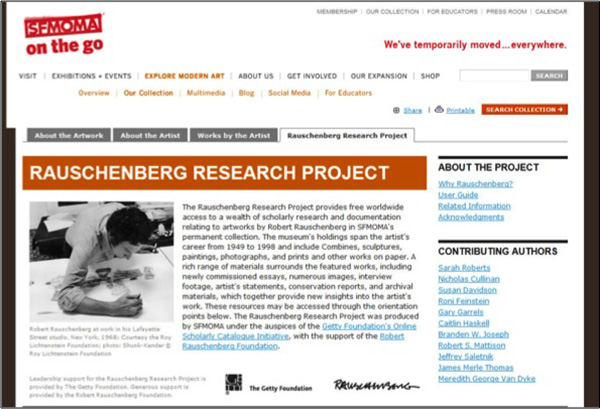
The newest OSCI publication, SFMOMA’s Rauschenberg Research Project, displayed on an iPad.
Scholars, museum-goers, art lovers: imagine, if you will, sitting in your favorite café or diner anywhere in the world—let’s say Paris or Port Arthur, Texas—and zooming into beautiful pictures of your favorite artwork by your favorite artist—let’s say Robert Rauschenberg—and impressing your dining companion with interesting factoids and interactive photos that take you below the picture surface to see how that favorite work was made.
Well, wait a minute. You don’t have to imagine.
You can actually do this, starting today.

Cover of SFMOMA’s OSCI publication, Rauschenberg Research Project.
The San Francisco Museum of Modern Art (SFMOMA) has released the Rauschenberg Research Project, the newest digital publication produced as part of the Getty Foundation’s Online Scholarly Catalogue Initiative (OSCI): a group of nine museums—including the J. Paul Getty Museum—working together to create new models for scholarly collection catalogues in the online environment. SFMOMA’s online catalogue on Robert Rauschenberg joins already released catalogues by Tate and the Art Institute of Chicago (preview, final version coming in 2014) in giving us readers a fuller sense of the possibilities that digital publishing offers. So, without further ado, let’s take a tour of some of the SFMOMA catalogue features, which incidentally point to five great reasons why museums should make the move to online publishing for permanent collection catalogues.

Screenshot of views of Robert Rauschenberg’s Erased de Kooning Drawing (1953) from SFMOMA’s OSCI publication.
REASON 1: More Timely Release of New Research
With digital publishing, gone are the days of waiting for the next edition to share research breakthroughs. As the “S” in OSCI states, scholarship is the centerpiece of the Getty-supported catalogues, and serious research forms the core of all featured content. For example, SFMOMA has discovered clues to what “lies behind” Rauschenberg’s seminal work Erased de Kooning Drawing. Many readers will be familiar with the story of this work from art history textbooks: The young Rauschenberg asked the older, more established de Kooning for a drawing and then audaciously erased it. Through exhaustive curatorial and conservation research, the SFMOMA team can now hypothesize about the appearance of de Kooning’s lost drawing. Scholars worldwide can quickly gain access to this new finding, without waiting for a book to be delivered to their doorsteps.

Still from 1999 video interview of Robert Rauschenberg discussing his Automobile Tire Print (1953) from SFMOMA’s OSCI publication.
REASON 2: Expanded, Multimedia Content
This is what the web was built for, and what the ever-growing host of social media sites thrive on—video and audio, as well as interactive features. Digital catalogues can now go far beyond printed quotes to reconnect the artist’s voice with his or her work of art. SFMOMA’s catalogue gives us many evocative examples of this, such as video footage of Rauschenberg walking through a 1999 exhibition at the museum and demonstrating the sound component of an artwork that would be quiet and motionless in a book illustration. By embedding segments from this reel in relevant catalogue entries, SFMOMA allows readers to build connections between analyses offered by scholars and those that come directly from the artist.

Documentation of the reverse of Rauschenberg’s White Painting (Three Panel), 1951, showing red thumbprint, from SFMOMA’s OSCI publication.
REASON 3: Enhanced Conservation Documentation
Museum collection catalogues now routinely include conservation documentation—materials that explain how a work of art was made, guide its ongoing preservation, and record efforts to safeguard it for posterity. But the space limitations of the printed book often constrain how much of this fascinating, behind-the-scenes material can be published. The digital format allows museums to include much more than ever before and at an enhanced level. SFMOMA has incorporated resources, such as more than 175 photographs of the featured artworks (including the backs of pieces, details, and archival views); early reviews and articles on the artist; conservation reports back to the 1970s; and treatment documentation, including informational videos. Here, again, new research findings are brought to light. Rauschenberg’s White Painting (Three Panel) from 1951, was famously described by Rauschenberg’s friend, composer John Cage, as “airports for shadows and for dust” in response to the panels’ seeming emptiness. But there is an intriguing history of the artist’s touch hidden beneath the surface: SFMOMA curators and conservators discovered red thumbprints buried underneath the folds on canvas on the reverse. Thought to have been added decades after the artist first conceived the White Paintings series, these newly discovered prints add a new dimension to our understanding of the timeline and process of Rauschenberg’s work.

Screenshot of views of Robert Rauschenberg’s Hiccups (1978) from SFMOMA’s OSCI publication.
REASON 4: Interactivity
Hiccups consists of 97 sheets of handmade paper joined by zippers. The work stretches to more than 62 feet in length and is, therefore, extremely difficult to illustrate on the printed page. By contrast, SFMOMA’s online catalogue offers an immersive sense of its sweeping scale via a high-resolution zoomable image that allows us to dive deeply into the smallest details of each sheet or visually glide along its extensive length.
REASON 5: A Direct Experience of Audio or Time-Based Artwork
Modern art in particular contains many examples of works that are time-based (such as video) or have other performative or audio dimensions. Yet the printed page has no sound or duration. In the 1950s and ’60s, Rauschenberg was captivated by how John Cage was rethinking music and how visual works could have sound components. As a sculptural thank-you to his friend and collaborator, Rauschenberg fashioned Trophy IV (for John Cage). But a still photograph could never fully capture this work, which awaits activation. Finally, in the digital catalogue, readers can hear the sound component of the piece, as the boot strikes a piece of shaped, contorted metal. For a work that is an homage to one of America’s most influential 20th-century composers, hearing this sound is arguably as important as seeing the sculptural form.
These are just a few morsels from the visual and intellectual feast that SFMOMA’s new OSCI publication offers. To dig deeper into these features and more, proceed to SFMOMA’s website to explore the Rauschenberg Research Project for yourself.




Comments on this post are now closed.